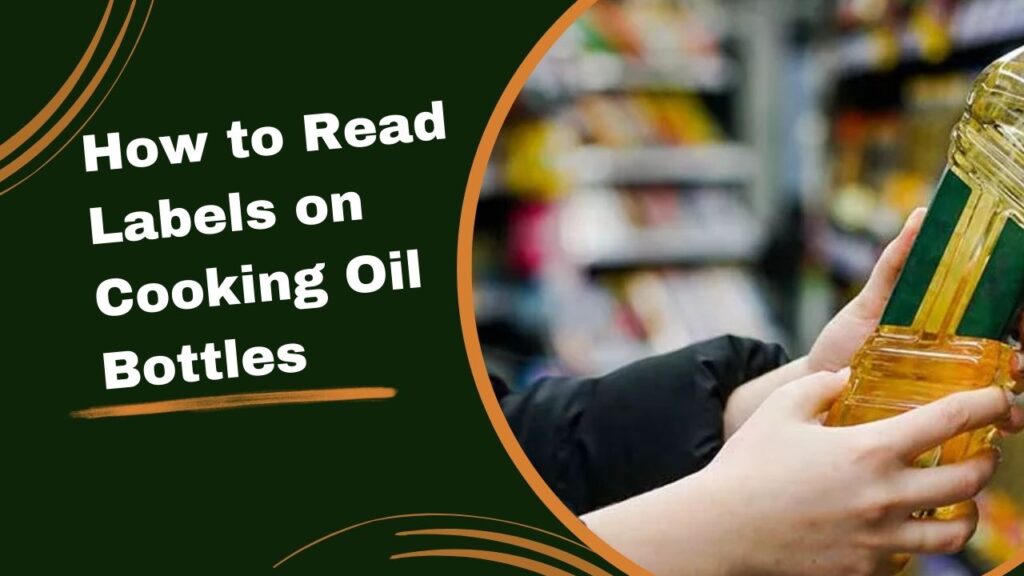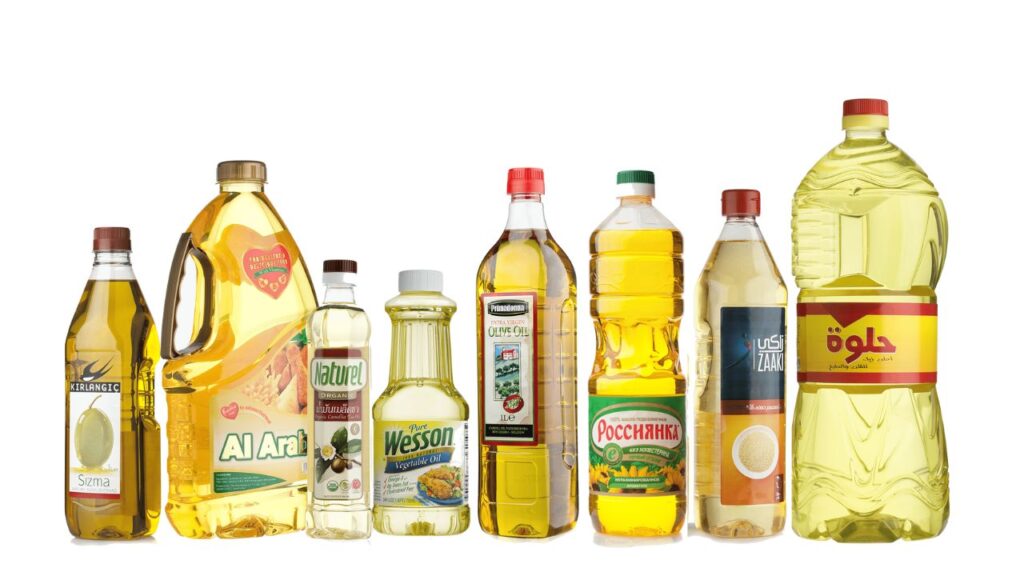
When you pick up a bottle of cooking oil, do you ever wonder what all those labels really mean? From “cold-pressed” to “extra virgin” and “non-GMO,” these terms can be confusing. But understanding them is essential for making healthier choices in your kitchen.
Cooking oils play a major role in our daily diet. They impact everything from heart health to the flavor of your meals. Some oils are packed with beneficial fats, while others may contain hidden trans fats that you should avoid. That’s why reading cooking oil labels is more than just a habit—it’s a way to take control of your nutrition.
In this guide, learn how to read labels on cooking oil bottles to choose the healthiest and best oils for your kitchen needs. Whether you’re looking for the best oil for frying, salad dressings, or heart-friendly options, you’ll learn how to decode labels like a pro.
Contents
What Information Can You Find on Cooking Oil Labels?
Cooking oil labels can be packed with information, but not all of it is easy to understand. If you’ve ever stood in the grocery aisle feeling overwhelmed by terms like “cold-pressed” or “refined,” you’re not alone! Here’s what you should look for on a cooking oil label and why each section matters.
Ingredients List
The first thing to check is the ingredients list. Some oils, like extra virgin olive oil, should contain just one ingredient—olive oil. However, many commercial vegetable oils may be blends of different oils, sometimes with additives or preservatives.
Tip: Always look for oils with minimal ingredients. The fewer, the better!
Nutritional Facts
This section provides key details about the oil’s fat content, calories, and serving size. Here’s what to focus on:
- Total Fat – Oils are pure fat, but the type of fat matters. Look for higher amounts of unsaturated fats, which are heart-friendly.
- Saturated Fat – Found in coconut oil, palm oil, and butter. Too much saturated fat may raise cholesterol levels.
- Trans Fat – Avoid at all costs! Trans fats are harmful and increase the risk of heart disease.
- Omega-3 and Omega-6 – Some oils, like flaxseed or walnut oil, are rich in omega-3s, which are great for brain and heart health.
Tip: Even if the label says “0g trans fat,” check the ingredients list for partially hydrogenated oils—that’s a hidden source of trans fat!
Processing Method
The way an oil is extracted affects its nutritional value and taste. Common terms include:
- Cold-pressed or Expeller-pressed – Extracted without high heat, preserving nutrients and flavor.
- Refined – Processed with heat and sometimes chemicals to remove impurities. Has a longer shelf life but fewer nutrients.
- Unrefined – Less processed and retains more natural antioxidants and flavor.
Tip: If you’re looking for the healthiest option, choose cold-pressed or unrefined oils whenever possible.
Certifications and Quality Seals
Certain labels indicate better quality and purity. Look for:
✅ Organic – No synthetic pesticides or GMOs.
✅ Non-GMO – The oil doesn’t come from genetically modified crops.
✅ Extra Virgin – Applies to olive oil; means the oil is unrefined and of the highest quality.
✅ Fair Trade – Ensures ethical sourcing and fair wages for farmers.
Best By Date and Storage Instructions
Cooking oils can go rancid over time. The best by date tells you how long the oil will stay fresh. Some oils, like flaxseed oil, need refrigeration, while others should be stored in a cool, dark place.
Tip: Rancid oil smells bad and loses its health benefits. If your oil smells “off,” it’s time to toss it!

Types of Cooking Oils and Their Labels
When you walk down the cooking oil aisle, you’ll see an overwhelming variety of options. Each type of oil has unique characteristics, and their labels provide essential details to help you choose wisely. Let’s break down some of the most common cooking oils and what their labels tell us.
Olive Oil: Extra Virgin, Refined, and More
Olive oil is a kitchen staple, but not all bottles are created equal. Here’s what to look for on the label:
- Extra Virgin Olive Oil (EVOO) – This is the least processed form, extracted purely from olives without heat or chemicals. Look for terms like “cold-pressed” or “first press”, which indicate minimal processing, preserving nutrients and antioxidants.
- Refined Olive Oil – This oil undergoes processing to remove impurities and extend shelf life. It has a lighter taste but lacks some of the beneficial compounds found in EVOO.
- Light or Pure Olive Oil – Don’t be fooled by the word “light.” It refers to the flavor and color, not calories. This version is often a blend of refined and virgin oils.
Label Tip: Choose extra virgin olive oil for dressings and low-heat cooking, while refined olive oil works better for high-heat cooking.
Coconut Oil: Virgin vs. Refined
Coconut oil has gained popularity for its versatility, but labels can be tricky.
- Virgin (or Unrefined) Coconut Oil – Extracted without heat, this oil retains its natural coconut aroma and flavor. The label may also mention “cold-pressed”, indicating minimal processing.
- Refined Coconut Oil – This version is processed to remove impurities and flavor, making it more neutral-tasting. It’s better suited for high-heat cooking.
Label Tip: If you want an unprocessed, natural option, go for virgin coconut oil. For deep frying, refined coconut oil is a better choice.
Vegetable Oils: Blends and Sources
Many cooking oils labeled as “vegetable oil” are blends, typically made from soybean, canola, corn, or palm oil. Here’s what to check on the label:
- Source of the oil – Some brands specify the primary oil (e.g., “100% soybean oil”), while others list a blend.
- Refined vs. Unrefined – Most vegetable oils are refined to remove impurities, which extends shelf life but reduces nutrients.
- Non-GMO or Organic – If you prefer a more natural option, look for “Non-GMO” or “USDA Organic” labels.
Label Tip: If possible, opt for single-source oils like canola or sunflower oil over generic vegetable oil blends for better transparency.
Specialized Oils: Avocado, Sunflower, and More
These oils are known for their unique health benefits and cooking properties.
- Avocado Oil – Rich in monounsaturated fats, it has a high smoke point and is great for frying. Look for “cold-pressed” on the label for minimal processing.
- Sunflower Oil – Often labeled as “high-oleic”, meaning it contains more heart-healthy fats.
- Sesame Oil – Comes in two types: light sesame oil (neutral and mild) and toasted sesame oil (rich and nutty flavor).
Label Tip: Check for “cold-pressed” or “expeller-pressed” to ensure minimal processing and better retention of nutrients.
Common Misconceptions About Cooking Oil Labels
Cooking oil labels can be tricky to decipher, and there are plenty of myths surrounding terms like “light,” “refined,” and “unrefined.” Let’s clear up some common misunderstandings so you can make more informed choices.
The Term “Light” Oil—What Does It Really Mean?
Many people assume that “light” oil is lower in calories or fat, but that’s not the case. The term “light” often refers to the oil’s color or flavor rather than its nutritional content. For example, “light olive oil” is more refined and has a milder taste than extra virgin olive oil, but both contain the same amount of fat and calories per serving.
Tip: Always check the nutritional information on food labels rather than relying on marketing terms like “light” or “pure.”
Refined vs. Unrefined Oils—Which Is Better?
There’s a lot of confusion about refined and unrefined oils. Here’s what you need to know:
- Refined Oils: These oils go through processing methods like bleaching, filtering, and deodorizing to remove impurities and extend shelf life. While this makes them more stable for high-heat cooking, some nutrients and natural flavors are lost in the process. Examples include vegetable oil, canola oil, and light olive oil.
- Unrefined Oils: These oils undergo minimal processing, retaining more flavor, aroma, and nutrients. However, they tend to have a lower smoke point, making them better for salads, dips, and low-heat cooking. Examples include extra virgin olive oil, cold-pressed coconut oil, and unrefined sesame oil.
Bottom Line: Choose refined oils for frying and high-heat cooking, and opt for unrefined oils for dressings, dips, and low-temperature uses.

How to Make Better Cooking Oil Choices
Now that you understand the labels, let’s talk about how to choose the best oil for your cooking needs.
Best Oils for High-Heat Cooking
When cooking at high temperatures (e.g., frying or sautéing), you need oils with a high smoke point—meaning they won’t break down and produce harmful compounds.
Here are some of the best oils for frying and high-heat cooking:
- Avocado oil (smoke point: ~520°F / 271°C)
- Refined coconut oil (smoke point: ~400°F / 204°C)
- Ghee (clarified butter) (smoke point: ~450°F / 232°C)
- Refined peanut oil (smoke point: ~450°F / 232°C)
- Light olive oil (smoke point: ~465°F / 240°C)
Tip: Avoid oils high in trans fats, as they can negatively impact heart health.
Best Oils for Dressings and Cold Dishes
Some oils shine when used raw, adding rich flavor and health benefits to salads, dips, and cold dishes. These oils are typically unrefined and rich in omega-3s and antioxidants.
Great choices include:
- Extra virgin olive oil – Great for salads, dips, and finishing dishes.
- Flaxseed oil – Packed with omega-3 fatty acids, ideal for drizzling.
- Walnut oil – Nutty flavor, excellent for cold applications.
- Sesame oil (unrefined) – Adds deep, toasty flavor to Asian dishes.
How to Store Cooking Oil Properly
Storing cooking oil correctly is essential for maintaining its freshness, flavor, and nutritional quality. Improper storage can lead to rancidity, making the oil unsafe for consumption. Follow these best practices to extend shelf life and preserve quality.
Best Storage Practices for Longevity and Flavor
- Keep It Cool and Dark – Store cooking oil in a cool, dark place, away from direct sunlight and heat sources like the stove. Light and heat can cause oxidation, leading to spoilage.
- Use Airtight Containers – Always tightly seal oil bottles after each use to minimize oxygen exposure, which can make oil go rancid faster.
- Choose the Right Container – Glass or stainless steel bottles are ideal, as plastic can leach chemicals into the oil over time. Dark glass bottles help protect against light damage.
- Refrigerate Certain Oils – Some oils, like flaxseed oil, walnut oil, and unrefined sesame oil, should be stored in the refrigerator to prevent oxidation. However, refrigeration may cause some oils (like olive oil) to solidify—just let them sit at room temperature before use.
- Keep It Away from Moisture – Avoid storing oil near steam or water sources (like above the sink), as moisture can lead to spoilage.
Expiration and Shelf Life of Cooking Oils
Even when stored properly, cooking oils don’t last forever. Understanding expiration dates and knowing how to check for spoilage will help you avoid using rancid oil.
Understanding “Best By” and Expiration Dates
Most cooking oils have a “best by” date, which indicates when they are at peak freshness. This is not the same as an expiration date, meaning the oil may still be safe to use after this period if stored correctly. However, over time, oils break down, losing their nutritional value and taste.
General Shelf Life of Common Cooking Oils:
- Extra virgin olive oil – 12 to 24 months (6 months after opening)
- Vegetable oil – 12 to 18 months
- Coconut oil – 2 to 3 years
- Avocado oil – 12 to 18 months
- Flaxseed oil – 6 months (refrigerated)
- Sesame oil – 12 months
How to Check for Spoilage
Even before the “best by” date, oils can turn rancid if exposed to heat, light, or air. Here’s how to tell if your oil has gone bad:
- Smell Test – Rancid oil often has a bitter, musty, or paint-like odor. If it smells unpleasant, don’t use it.
- Taste Test – Fresh oil should taste neutral or slightly nutty. If it tastes bitter, soapy, or stale, it’s past its prime.
- Texture & Appearance – If the oil appears cloudy, thick, or sticky (and it’s not an oil that solidifies in the cold), it may be deteriorating.
Tip: When in doubt, throw it out. Using rancid oil can lead to digestive discomfort and reduce the quality of your dishes.
Conclusion
Understanding cooking oil labels and proper storage can help you make healthier, better-tasting choices in the kitchen. By following best storage practices, checking expiration dates, and choosing the right oil for the right use, you can enhance both the flavor and nutritional value of your meals.
Key Takeaways:
✔️ Look beyond marketing terms like “light” oil—always check labels for nutritional details.
✔️ Store oils in a cool, dark place in airtight containers to prevent spoilage.
✔️ Choose high-smoke-point oils for frying and delicate oils for dressings.
✔️ Always check for rancid smells, bitter taste, or thick texture before using.
Next time you grab a bottle of cooking oil, take a moment to read the label carefully and store it properly—your health and taste buds will thank you! 😊
FAQ
Q1: What is the difference between extra virgin olive oil and refined olive oil?
Extra virgin olive oil (EVOO) is minimally processed, retaining more antioxidants and flavor, while refined olive oil undergoes processing to remove impurities, making it more suitable for high-heat cooking.
Q2: How do I know if the cooking oil is healthy?
Look for oils rich in unsaturated fats (like olive oil or avocado oil) and low in trans fats. Also, check for organic, cold-pressed, or non-GMO labels.
Q3: What oils should I avoid for frying?
Avoid oils with low smoke points, such as extra virgin olive oil, flaxseed oil, and unrefined walnut oil, as they can burn and develop harmful compounds.
Q4: Can cooking oils expire?
Yes, all oils have a shelf life. Expired or rancid oils develop an off smell, bad taste, or thick texture. Proper storage extends freshness.
Q5: How do I read the “cold-pressed” label on oils?
“Cold-pressed” means the oil was extracted without heat, preserving more nutrients and flavor. These oils are best used in dressings and cold dishes.

